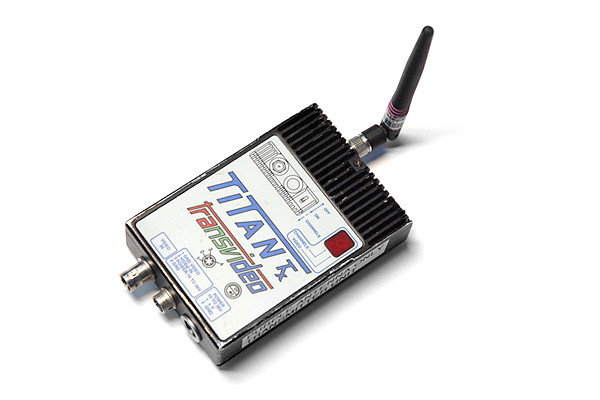back to Video Cameras >
Transmitters, Receivers

The first multi-directional Microwave Wireless Transmitter and receiver system
broadcasting through obstacles without desynchronization of the video picture.
- ideal for all Body-rig operators; the signal remains stable even both the Transmitter and the Receiver are in motion.
- very user friendly: the 4 channels are pre-dialed and accessible with the flip of a switch. No tools required.
- transmits & receives NTSC, PAL and SECAM color signals as well Black and White.
- operates on 9-36 V DC via Lemo 2 or Hirose 6 connectors. The Hirose 6 connector carries video out (Receiver) or video in (Transmitter) and accepts DC in.
- Transmitter and Receiver weigh 7oz (200g) each. Very compact they can be easily velcroed to any camera or monitor.
- 2.4Ghz channels:
A= 2.4125 Ghz
B= 2.4275 Ghz
C= 2.4425 Ghz
D= 2.4575 Ghz
WIRELESS VIDEO WARNINGS AND TIPS
Since the first wireless video transmitters were developed there have been millions of devices built and put in current use that use the RF bandwidth for very many purposes. Start with your cell phone and the millions of others all transmitting at the same time, full time. Then we have blue tooth and hot spots and wifi.
Don't forget about security systems, wireless drone and game machines and countless of other radio frequency emissions. All of these signals are out there to compete with your single video path.
The success of a video transmission, therefore, depends on a huge number of competitive signals all fighting for the space. If you change the frequency of the intended video path you have extra chances of a clean signal if your choice of a frequency is not one of the competitive signals or a multipath frequency.
The first and most important guideline for a user of this equipment is to run a test in advance of the event, performance or videotaping/screening of the signal.
If the advance test works fine...and note that with with the TransVideo STANDARD DEFINITION wireless video you have a switchable selection of four frequencies which can, in a clean and signal-free environment deliver a clean video image over anywhere from 50 to 1000 feet depending on the environmental makeup of the location. RF does not like metal of any kind (look up Faraday cage in google-this is a place designed so that NO signals can penetrate discovered in 1836). Clear line of sight from the antenna of the transmitter to the receiver is the ideal arrangement. Helicopters have been used for years as a reliable relay station from ground level signals to a broadcast, live, or video taped, if unmovable obstructions like buildings, vehicles, or other potential signal blocking structures are encountered.
Receiver positioning is extremely important. Think about the signal blocking as described above. If you can place the receiver above the area where you are transmitting from that simple relocation (taking the video signal from the receiver with a simple BNC cable to the recorder or live feed.
Keep in mind that once you have done the first step of testing to a perfect signal prior to the "go time" your next contest is to avoid and eliminate as many of the portable and temporary devices that will bring new and untested RF (EMF) signals to the location.
If the signal is in any way degraded on the work day, start with eliminating cell phones and any new switched on devices. Relocate the actual receiver.
These transmitter-receivers can do a good job. If conditions are compatible with them great.
If not, then the options become expensive as in $1500 a day or more for a serious and state-of-the-art high definition broadcast system.
Call Budget Video Rentals 24/7 for further technical assistance